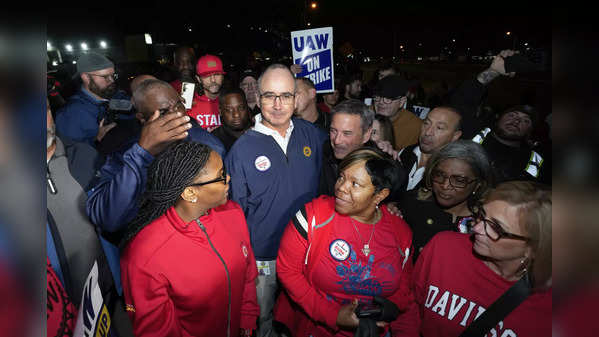Explainer: US auto workers are on strike against Ford, GM, Stellantis

15-Sep-2023 07:58 PM
The United Auto Workers union initiated coordinated strikes at three plants under the ownership of major automakers: General Motors, Ford, and Stellantis (Chrysler's parent company) on Friday. This marks the most significant industrial labor action in the United States in decades.These strikes will disrupt the production of several well-known models, including the Ford Bronco, Jeep Wrangler, and Chevrolet Colorado pickup truck, among others.
Just after midnight on Friday, the United States auto workers' union initiated a targeted strike at three factories, marking the first simultaneous stoppage at Detroit 's "Big Three." This dramatic walkout, celebrated with spirited honking and cheers outside a Ford plant in the Detroit area upon the arrival of the United Auto Workers ' leader, occurred following a last-minute effort by General Motors, Ford, and Stellantis to reach an agreement before the contract's expiration. UAW President Shawn Fain announced in a webcast shortly before the September 14 deadline, "Tonight, for the first time in our history, we will strike all three of the Big Three at once." Here are some FAQs on why the UAW is on strike: Why auto workers are on strike: Wages: The UAW is demanding a significant wage increase for its members. The union is seeking a 36% increase in general pay over a span of four years, which would raise the current hourly wage of a top-scale assembly plant worker, currently at around $32 an hour. The union argues that autoworkers have made sacrifices in recent years, and they deserve to be compensated for their hard work. The automakers have offered some wage increases, but the UAW says that they are not enough. Benefits: The UAW is also demanding better benefits for its members, including improved healthcare coverage and retirement benefits. The union argues that the automakers can afford to provide better benefits, and that they should do so in order to attract and retain workers. The automakers have offered some improvements to benefits, but the UAW says that they are not enough. Job security: The UAW is also demanding that the automakers commit to creating new jobs in the United States. The union is concerned about the automakers' plans to move more jobs to Mexico and other countries. The automakers have said that they are committed to creating new jobs in the United States, but the UAW wants more specific commitments. Q: How many workers are on strike and where are they located? According to UAW estimates, approximately 12,700 workers went on strike on Friday. However, this represents only a fraction of the 150,000 auto workers represented by the union. The following are the initial facilities where strikes have occurred: General Motors Wentzville Assembly Plant in Missouri, comprising approximately 3,600 UAW members. It manufactures Chevrolet Colorado and Express, as well as GMC Canyon and Savanna. Ford Wayne Assembly Plant in Michigan, excluding the stamping plant, with around 3,300 UAW members. It is responsible for producing Ford Ranger and Bronco. Stellantis Toledo Assembly Plant in Ohio, involving roughly 5,800 UAW members. This facility manufactures Jeep Wrangler and Gladiator. Q: How long will the strike last and what are the consequences? A: The duration of the strike is uncertain and depends on how quickly the UAW and the automakers can reach a deal. The last major strike by UAW against GM in 2019 lasted for 40 days and cost GM $3.6 billion. A prolonged strike could have a significant impact on the US economy, as well as on the workers' income and benefits. The UAW provides $500 per week in strike pay to its members, which is much less than their regular wages. Q: What are the chances of a resolution and what are the main sticking points? A: The UAW and the automakers have been negotiating for months, but have not been able to bridge their differences on several key issues. Some of the main sticking points are: Q: What are the potential consequences of a long strike? A: A long strike could have a number of negative consequences. It could lead to job losses, plant closures, and a decline in the US auto industry. It could also have a negative impact on the economy as a whole. The UAW president Shawn Fain has said that he is ready to fight for a fair contract that reflects the hard work and sacrifices of his members. The automakers have said that they are disappointed by the UAW's actions and that they are offering a generous package that includes wage increases and manufacturing commitments. Both sides have expressed their willingness to continue bargaining in good faith until they reach an agreement.